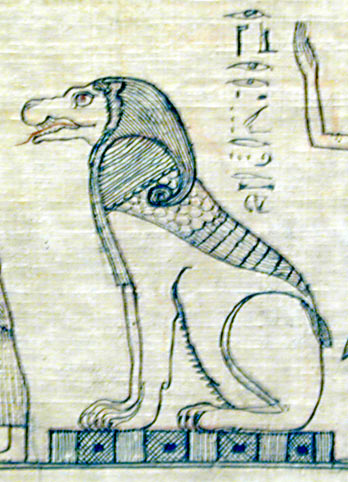Ammit
From Wikipedia, the free encyclopedia
In Egyptian mythology, Ammit (also spelt Ammut, Ammet, Amam, Amemet and Ahemait) was the personification of divine retribution for all the wrongs one had committed in life and she dwelt in the Hall of Ma'at. Ammit was said to live near the scales of justice, in the underworld, Duat, where the hearts of the dead were weighed by Anubis against the feather in Ma'at's headdress. Ma'at was regarded as the personification of the principles of truth and justice. The hearts of those who failed the test were given to Ammit for her to devour, and their souls were not permitted to enter Aaru, having to be restless forever—dying a second time.
Ammit was not worshipped, and she was never regarded as a goddess. Instead, she embodied all that the Egyptians feared, threatening to bind them to eternal restlessness if they did not follow the principle of Ma'at. Thus Ammit was depicted with the head of a crocodile or dog, the front part of her body as a lioness or leopard, and her hind quarters in the form of a hippopotamus, a combination of those animals which were considered as the most dangerous to the ancient Egyptians. Although often referred to as a demon, technically, however, in destroying evil she acted as a force for good.
| Ammit in hieroglyphs | |||||||
|
Her role is reflected in her name, which means Devourer or, more accurately, and less euphemistically, Bone Eater, and her titles such as Devourer of the dead, Devourer of millions (Am-heh in Egyptian), Eater of hearts, and Greatness of Death. In some traditions, Ammit was said to stand by a lake of fire, into which the unworthy hearts were cast, rather than her eating them. In this role, Ammit was more the lake guardian than the destroyer, which some scholars believe may be evidence of syncretism of a fiery lake belief, from an as yet unidentified elsewhere. In still another version, Ammut ate the condemned person, rather than only the heart. An evil person then dissolved forever in her stomach.

Some experts have linked Ammit with the goddess Taweret, who has a similar physical appearance and, as a companion of Bes, also protected others from evil. Other authors have noted that Ammit's lioness characteristics, and the lake of fire, may be pointers to a connection with the goddess Sekhmet.
Although Ammit is seen as a devouring entity, its order is neutral and strictly serves at the whim of the other deities to take souls that have sinned against the gods and put them into oblivion.
[edit] See also
Ammyt
De Wikipedia, la enciclopedia libre
Ammyt, la "devoradora de los muertos" o "devoradora de corazones", en la mitología egipcia.
- Nombre egipcio: Ammyt (otras grafías: Ammit, Ammut, Amemet o Amam).
Iconografía [editar]
Era representada como un ser con cabeza de cocodrilo, la parte delantera de león y la trasera de hipopótamo.
Mitología [editar]
Ammyt se situaba bajo la balanza en el Juicio de Osiris, celebrado en la Duat, el inframundo. Dyehuty (Tot) comparaba el peso del corazón del difunto "Ib", símbolo de los actos pasados terrenales, la conciencia y moralidad, contra la pluma que representaba la Maat, la Verdad, Juticia y Armonía Universal.
Para que el difunto pudiera ser considerado “Justo de voz”, el corazón y la pluma debían ser igual de ligeros. Si el corazón pesaba más que la pluma era considerado impuro, Ammyt lo devoraba y a la persona juzgada no se le concedía entrar en el Aaru, perdiendo su condición de inmortal, pereciendo definitivamente.
| Ammyt en jeroglífico |
|
Enlaces externos [editar]
Languages
Obelisk of Africa
doox420Página PRINCIPAL
OBRAS y AUTORES CLÁSICOS
Agradecimientos
Cuadro General
Disculpen las Molestias
Religión Católica (2020)SK | PAPAS - POPES
IGLESIA DE ESPAÑA: GALICIA |
EGIPTOLOGÍA (2494) | HINDUISMO (3270)SC
Otros Apartados
| Main | SWAMIS · Mejoras · Catholics |
|---|





No hay comentarios:
Publicar un comentario